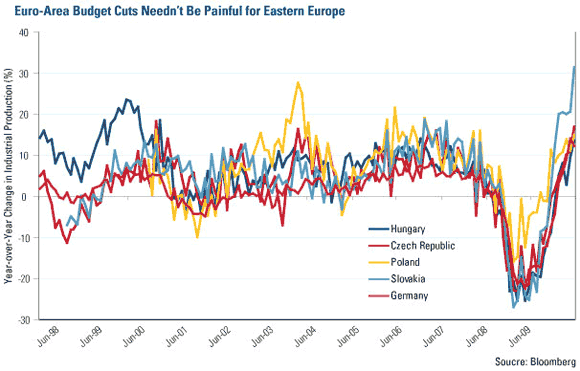Weakness in the euro is a strength for Emerging Europe.
A strong currency tends to make exports more expensive, but Germany (the world’s #2 exporter behind China) remained globally competitive even as the euro’s value climbed to record highs against the U.S. dollar.
One of the key reasons: German manufacturers cut costs by shifting some production to Emerging Europe, where skilled workers are readily available at a far lower wage. The Czech Republic, Poland and other Emerging Europe countries send semi-finished goods to Germany, where they become finished products for export, primarily to Asia and North America.
According to some estimates, this strategy has raised the productivity of the German parent companies by 20 percent.

The euro has depreciated in recent months due to worries about the massive sovereign debt loads in Greece, Spain and other countries. Emerging Europe, by contrast, has much lower debt-to-GDP ratios, which enables higher growth rates.
The weaker euro has helped German exporters by making their products less expensive abroad, and as we pointed out in our latest Weekly Investor Alert, Emerging Europe has also gotten a lift.
The chart above shows the industrial production growth trend (rolling six months) for several Emerging Europe countries, along with Germany’s export growth outside the European Union.
Germany’s overall exports rose 9 percent in May to $98 billion, and were up 29 percent through the first five months of 2010. The government in Berlin now envisions GDP growth of 2 percent this year, higher than the official estimate of 1.4 percent – this would further benefit Emerging Europe.
- Bulenox: Get 45% to 91% OFF ... Use Discount Code: UNO
- Risk Our Money Not Yours | Get 50% to 90% OFF ... Use Discount Code: MMBVBKSM
Disclaimer: This page contains affiliate links. If you choose to make a purchase after clicking a link, we may receive a commission at no additional cost to you. Thank you for your support!


Leave a Reply